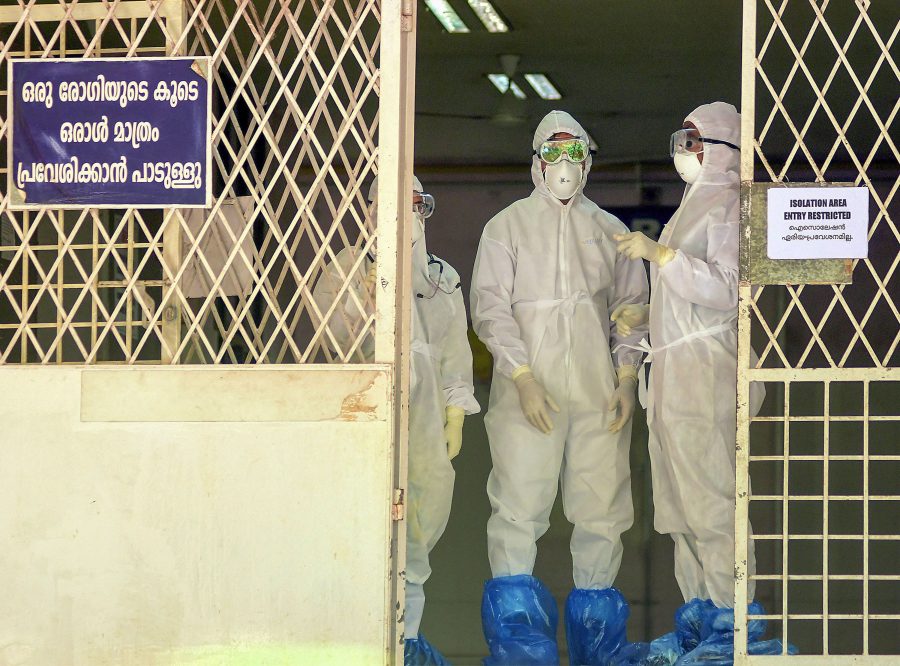
Karnataka govt asks districts to strengthen preparedness in wake of Nipah virus

The Karnataka government directed the districts bordering Kerala to strengthen surveillance and preparedness in the wake of the Nipah virus in the neighbouring state.
The government said that all people coming to the state from Kerala should be monitored for symptoms like fever, altered mental status, severe weakness, headache, respiratory distress, cough, vomiting, muscle pain, convulsion and diarrhoea.
A 12-year-old boy died of the Nipah virus infection at Kozhikode in Kerala on September 5. The test results of eight people, including the child’s parents and health care workers, who came in close contact with him, were found to be negative.
The Kerala government had put the health departments in four districts, which include, Kozhikode, neighbouring Kannur, Malappuram and Wayanad, on high alert.
Also read: Nipah outbreak: What Kerala is doing to contain it
“In view of confirmed cases of Nipah virus (NiV) infection reported recently in the neighbouring state of Kerala, it is imperative to strengthen the surveillance and preparedness in the larger interest of Public Health in Karnataka also, with special focus in the districts bordering Kerala: Dakshina Kannada, Udupi, Mysuru, Kodagu and Chamarajanagara,” the government advisory said.
The advisory, which was issued by Jawaid Akhtar, Additional Chief Secretary, Department of Health and Family Welfare, gave certain instructions to be implemented by district administrations to ensure the wellbeing of the community, that includes monitoring those coming from Kerala for symptoms.
“Also, necessary public awareness should be spread among the public on Nipah,” the advisory said, adding that systematic surveillance system is a necessary method to identify clusters of encephalitis cases, resulting in early detection of Nipah outbreaks.
The advisory also said that suitable samples have to be collected with all necessary precautions from suspected, probable and contacts and sent to the National Institute of Virology, Pune, for laboratory confirmation.
Also read: Kerala’s tryst with Nipah: A tale of scare, vigilance and tears
“As there is no known treatment or vaccine available, Ribavirin, an antiviral, may have a role in reducing mortality among patients with encephalitis caused by Nipah virus disease,” the advisory said, adding that intensive supportive care with treatment of symptoms is the main approach for managing the infection in people.
The advisory instructed district authorities to send the daily reports, even if no cases were reported, in a prescribed format, to the Commissioner, Health and Family Welfare Services, Arogya Soudha, Bengaluru. “District Authorities should take all the necessary measures as instructed and as per the local situation,” it added.
Stating that Human Nipah Virus (NiV) infection is an emerging zoonotic disease, the Health Department said that in India, two outbreaks in humans were reported from West Bengal and neighbouring Bangladesh in 2001 and 2007. Further, confirmed cases and deaths were also reported from Kerala during the 2018 outbreak.
Large fruit bats of the Pteropus genus are the natural reservoir of Nipah virus, whose cases tend to occur in a cluster or as an outbreak.
The advisory said that in general, the case-fatality rate is estimated at 40-75 percent, but this rate can vary by outbreak and can be up to 100 percent.
Also read: Heart-wrenching: How Nipah virus took away life of a chirpy 12-year-old boy
Nipah virus has returned to Kerala after a 12-year-old boy succumbed to the infection on Sunday, which was the first such incident three years after it wreaked havoc in parts of Kozhikode and Malappuram districts in May 2018.
As Kerala reeled under a daily increase of nearly 30,000 cases of COVID-19, the deadly Nipah virus has added to the worries of the health officials, and has prompted the state to further heighten its health machinery to prevent an outbreak of a different infection.
(With inputs from Agencies)

